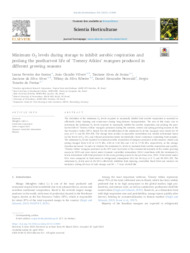Minimum O2 levels during storage to inhibit aerobic respiration and prolong the postharvest life of Tommy Atkins mangoes produced in different growing seasons.
Minimum O2 levels during storage to inhibit aerobic respiration and prolong the postharvest life of Tommy Atkins mangoes produced in different growing seasons.
Author(s): SANTOS, L. F. dos; VILVERT, J. C.; SOUZA, T. A. de; ALVES, J. da S.; RIBEIRO, T. da S.; NEUWALD, D. A.; FREITAS, S. T. de
Summary: The definition of the minimum O2 levels required to maximally inhibit fruit aerobic respiration is essential to efficiently delay ripening and senescence during long-distance transportation. The aim of this study was to determine the minimum O2 levels required to maximally inhibit the aerobic respiration and prolong the post- harvest life of ?Tommy Atkins? mangoes produced during the summer, winter and spring growing seasons in the S ?ao Francisco Valley (SFV), Brazil. For the identification of the minimum O2 levels, mangoes were stored for 42 days at 9 ?C and 90?95% RH. The change from aerobic to anaerobic metabolism was weekly determined based on the levels of O2, CO2 and ethanol production inside hermetically closed containers containing fruit samples. The minimum O2 levels required to maintain aerobic respiration of mangoes produced in the summer, winter and spring changed from 0.25 to 13.75 kPa, 0.80 to 2.30 kPa and 1.42 to 17.40 kPa, respectively, as the storage duration increased. In order to validate the minimum O2 levels to maintain fruit aerobic respiration and quality, ?Tommy Atkins? mangoes produced in the SFV were harvested at the commercial maturity in the winter growing season in 2022 and were stored under dynamic controlled atmosphere (DCA) conditions with the minimum O2 levels determined with fruit produced in the same growing season in the previous year, 2021. Fruit stored under DCA were compared to fruit stored in refrigerated atmosphere (RA) for 60 days at 9 ?C and 90?95% RH. The minimum O2 levels used in the DCA effectively inhibited fruit ripening, controlled black flesh and reduced rot incidence during 60 days of cold storage and 60 + 7 days of shelf life.
Publication year: 2023
Types of publication: Journal article
Unit: Embrapa Semi-arid Region
Keywords: Atmosfera controlada, Atmosfera controlada dinâmica, Etanol, Fruta, Limite inferior de oxigênio, Manga, Mangifera Indica, Mangoes, Postharvest physiology, Postharvest technology, Postharvest treatment, Pós-Colheita, Pós-vida útil, Respiração Aeróbica, Respiração aeróbica das frutas, Tommy Atkins
Observation
Some of Embrapa's publications are published as ePub files. To read them, use or download one of the following free software options to your computer or mobile device. Android: Google Play Books; IOS: iBooks; Windows and Linux: Calibre.
Access other publications
Access the Agricultural Research Database (BDPA) to consult Embrapa's full library collection and records.
Visit Embrapa Bookstore to purchase books and other publications sold by Embrapa.

